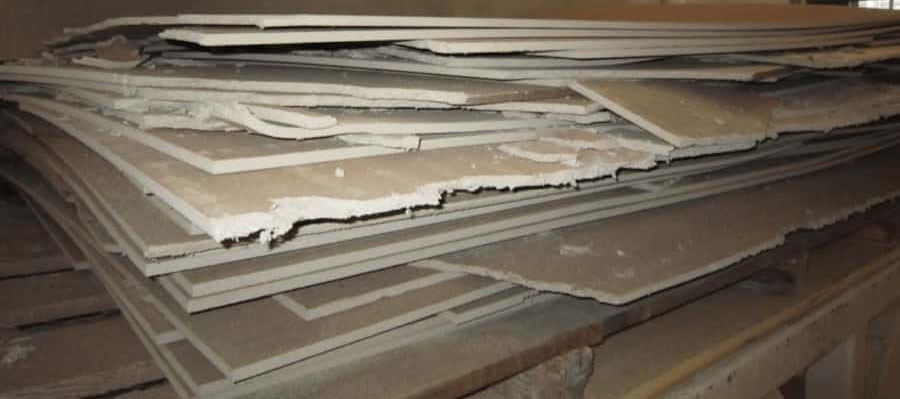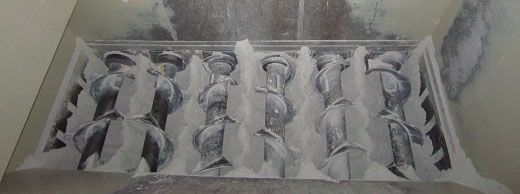Plasterboards
ACA crushers
Recycling of plasterboard and production waste
Crusher for recycling of plasterboards and production waste for use in the production of new plasterboards.
The crusher/mill is particularly suited for the crushing of gypsum without creating paper contamination in the final gypsum product. This applies to plasterboards, production waste as well as offcuts from new plasterboards.
Reuse to make new plasterboards
The ACA mill crushes the plasterboard and separates the gypsum from the paper, which is later removed. Once the paper has been removed, the gypsum can be used in the production of new plasterboards.
Very economical machine and easy to adjust
This crusher is slow-turning which makes it both efficient and economical. And makes it super strong as well. The size of the plasterboard output can easily be adjusted as desired.

Crush the plasterboard and recycle the gypsum residue
The plasterboard mill for recycling of faulty production of plasterboards from gypsum manufacturers in 24/7 operation.
The ACA crusher is fitted with a large hopper which is adjusted to the customer’s requirements. The waste can easily be loaded into the hopper with the help of a Digger or from a conveyor belt.
Coarse crusher for plasterboards operating 24/7
The plasterboard crusher is available in various versions. The mill can be supplied in standard sizes with 2, 3, 4, 6, 8, or 10 screws depending on the size of the input material and the desired amount of output.
Recycling of plasterboards
The ACA machine crushes the gypsum and separates it from cardboard and paper in order to use it in the production of new plasterboards.
Effective crusher for crushing of plasterboards
The mill produces an even flow of output. This makes it much easier to optimize the subsequent screening of the material to suit the rest of the production process.

Large tailor-made hopper for plasterboard
The large and customized hopper makes sure that the plasterboard easily can be loaded from either a conveyor belt or digger.
Slow-turning crusher for plasterboards
With only 15 RPM and a torque of 13.000 N the slow-turning crusher will be both economical and efficient – also the amount of dust is limited.
Strong mill for crushing of plasterboards and gypsum residue
With a weight of between 5 and 20 tonnes, a torque of 13,000-newton meters and reverse operation in the event of excess current, breakdown of the crusher can be avoided, and many years of useful life and safe, reliable 24/7 operation in the company is assured.

Hopper for plasterboards to be crushed.
Low noise level
As the machine is slow-turning, the noise level is as low as 75 DB when the machine is empty. The only thing you hear is the cooling of the machine.
Cheap in operation
Because the movable parts of the machine do not touch each other, it gives you a long useful life of the parts. The plasterboards are crushed against each other and thereby separating the plasterboards gypsum and the paper for subsequent sorting.
Output: plasterboard and gypsum residue
The ACA crusher’s flexible design makes it easy for the user to regulate the size of the output material by adjusting the rotating knives. The knives are easy to replace.
Crushing of plasterboard without pollution
The plasterboard crusher/mill is extremely well suited for the crushing of gypsum withoutcreating paper (fiber) contamination in the final gypsum product. This applies to plasterboards, production waste and offcuts from new plasterboards, which can subsequently be used in the production of new plasterboards.
Faulty plasterboards from gypsum manufacturers.
Can crush all types of plasterboards
The recycling of material plays an increasing role in modern society both from a financial point of view and out of concern for the climate and the environment, as it is uneconomical and unsustainable to only use virgin materials.
The use of gypsum in the production of new plasterboards thus presents many advantages, and all types of gypsum can be recycled.
Modern plasterboards are a very broad-spectrum product. In some cases, different molecules and substances may be added to make the plasterboard actively absorb and release heat, which means that the plasterboard can play a role in regulating the indoor temperature in office environments.
This type of gypsum can still be recycled, so the more gypsum waste and offcuts that can be collected for recycling, the better.
The crusher separates the crushed gypsum, paper, and other materials, if any, producing a very pure fraction that is highly suitable for further recycling.
This separation of paper, fiber, and pure gypsum determines the degree to which the gypsum output from the crusher can be recycled.
The paper can also be used in the production of new paper, but another option is to send it to an incineration plant, where it will contribute to the production of CO2-neutral electricity and heating.

Screened gypsum ready to be recycled as new plasterboards
After screening of the crushed material you are typically left with three fractions: gypsum, paper and metal.

Gypsum paper after screening
The screening of the gypsum leaves behind large pieces of paper with bits of gypsum attached, which can be recycled later.